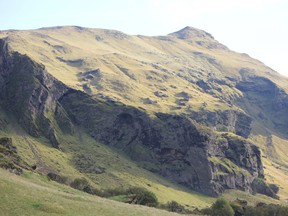
Reviews and recommendations are unbiased and products are independently selected. Postmedia may earn an affiliate commission from purchases made through links on this page.
Article content
We had driven maybe 10 kilometres from the international airport when the landscape went from ordinary to something else entirely.
Advertisement 2
Article content
In uninhibited view was a mashup of volcanic rock and swaths of mossy green partially bathed in wide strips of fog set against blue skies. It was an incomparable sight, like nothing I had ever seen before.
Article content
Here, on a curiously quiet two-lane road hugging the coast of the North Atlantic Ocean, we were destined for somewhere that was seemingly nowhere at all. Surely, up ahead in the distance would be the end of the Earth or some such nothingness.
Were we in some sort of picturesque gravel pit? Had we missed the sign saying welcome to the moon? Or was this Mars?
As I wrote this, I feared I was being too theatrical with the descriptions of my first moments in Iceland — a country that, along with Ireland, had always felt entirely mythical, prior to actually visiting. I referred to my travel notes to verify my recollections.
Advertisement 3
Article content
“Weird. Strange. What the heck is this place?” were my first words jotted down upon arrival.
This “place” — specifically the south coast of Iceland — would be revealed throughout a five-day stay. It turns out it was a place much more special than even my most vivid imaginings could conceive. To scratch the lava-scorched surface: Extreme landscapes, contrasts, temperamental weather and patient, friendly locals. Home to hotdogs and fermented shark, Northern Lights and geysers, volcanoes, lava fields, glaciers, The Hidden People, lagoons and waterfalls, Viking heritage, Icelandic horses and black sand beaches.
To step foot on this barren island is to stand in awe of some of the most uncommon and stunning nature on the planet. It’s a place to explore and to discover, to embrace all that is wild, unpredictable and surprising, and to wash it all down with a shot of Brennivin schnapps and hope to get to do it all again as soon as possible.
Advertisement 4
Article content
Iceland is aptly called the Land of Ice and Fire for its hyperactive volcanoes and glaciers, but it could also be called the Land of Something New At Every Turn That Is Even More Amazing Than The Thing That Came Before It. On second thought, maybe best to stick with the more marketable fire and ice slogan. Just know that anyone with a pulse should find Iceland magical and memorable. And almost indescribable.
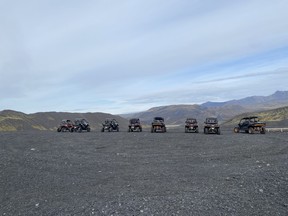
ADVENTURE-SEEKERS, START YOUR ENGINES!
There were two instances during our buggy tour through the Pórsmörk nature reserve in the highlands of southern Iceland where I actually found myself at a T-intersection and looking both directions before proceeding. Old habits die hard, but considering there were only a handful of us riding all-terrain vehicles in the middle of this vast treasure of land nestled among glaciers, I might have been OK to bend the rules of the road this time around.
Advertisement 5
Article content
When we finished the “Pórsmörk Buggy Adventure Ride,” offered by Southcoast Adventure, I told my group it was the most fun I’d ever had — and I wasn’t lying.
We visited the Gígjökull glacier and the Hidden Valley of Thor, which is showcased on Game of Thrones and for good reason. We flung dirt around at speeds of about 60 km/h while also splashing our way across streams before returning sporting huge grins on our seriously dirty faces.
There are a range of tour lengths and price points offered.
PRO TIP: Prepare to get absolutely soaked and seriously dirty.
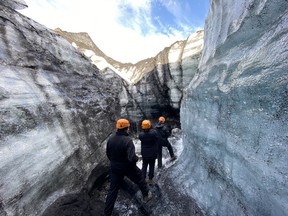
GET A GRIP!
A cave inside a glacier? How cool is that?
Inside the Katla ice cave, the temperature is fairly comfortable, so by no means will you turn into an icicle. Our friends at Southcoast Adventure brought us to the glacier in style via a “Super Jeep,” a monster-truck-like vehicle that seats 18 and could probably crush a two-storey house if necessary.
Advertisement 6
Article content
After the 45-minute drive from the nearest town, Vik, we arrived at the Mýrdalsjökull glacier. We strapped on our crampons and helmets before making the short hike to the cave entrance, where we used a series of ropes, small wooden bridges and our favourite prayers to safely explore the ice dome.
The scene inside the cave is something of a fairytale, featuring gem-blue colours and volcanic ash while glacier melt drips all around.
Some scenes from Interstellar were filmed in this area.
In case you thought your wedding was super-unique, we encountered newlyweds from Miami, including a bride in her wedding dress who had just returned from the cave with her bridal party.
PRO TIP: Take your time and ensure your footing is solid each step of the way as there is little room for forgiveness in and around the ice cave.
Advertisement 7
Article content
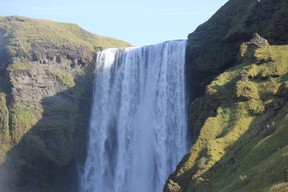
LEGENDS OF THE FALLS
For a slower pace, consider checking out one of Iceland’s stunning waterfalls. There are said to be something in the neighbourhood of 7,000 waterfalls on the island, which makes sense as it’s pretty much impossible not to see at least one from the road every few minutes — at least on the south coast.
We visited Skógafoss and Seljalandsfoss just as Justin Bieber did when he used the roaring water as backdrops to his 2015 video for I’ll Show You. Skógafoss is perfectly straight, while you can walk behind the roaring falls of Seljalandsfoss.
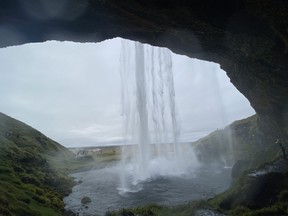
No trip to Iceland is complete without a visit to a black sand beach. We took in the most famous of all, Reynisfjara, with its sea-cooled lava from nearby Katla volcano and iconic basalt column formations.
Advertisement 8
Article content
PRO TIP: There are about 500 steps to the top of 62-metre-high Skógafoss, but the views are well worth it.
WHAT LIES BENEATH
The Caves of Hella were home to someone, but when they were built and by who remains a mystery.
“There obviously was some sort of community here that lived in these caves,” our expert guide Dora told us as we toured four of Hella’s 12 man-made caves that were first opened to the public in 2019.
Some sources suggest the caves were made by Celts who inhabited Iceland before the official Norse settlement in the late 9th century.
This cultural heritage site gives visitors a close-up look at this unique cave system that was used as dwellings, sheep sheds or storage. These are among about 100 caves in Iceland.
Advertisement 9
Article content
PRO TIP: The temperature inside the caves is even at 4C, so you’ll be comfortable as you sample some local whiskey, beer and Brennivín at the conclusion of the tour.
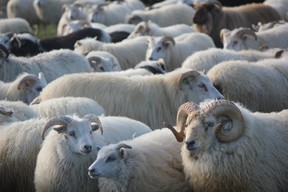
SHEER DETERMINATION
The locals were not trying to pull the wool over our eyes here. In fact, they were entirely welcoming.
In what can only be described as the most hyper-local activity possible, a group of North American journalists were invited to witness the annual sheep réttir in the southern Iceland countryside of Fljótshlíð.
What is a réttir? It’s a sheep-wrangling event held each fall where rural communities come together to collect and sort their sheep, which have been shepherded down from the highlands ahead of winter. Picture a giant pizza wheel where each farmer gets a “slice” of pizza. Using a number system coinciding with ear tags on the sheep, community members — including children — grab the sheep by the horns and bring them to their respective pens.
Advertisement 10
Article content
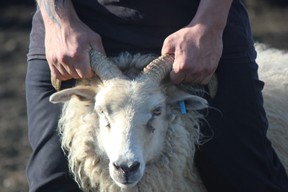
The tradition has been taking place for 300 years and is often followed by a meal of “meat soup,” where families empty their freezers to make way for incoming stock. We were graciously hosted by a local family and thoroughly enjoyed the soup, and the singing!
PRO TIP: If you’re in the south, visit a mill such as Uppspuni to learn about how Icelandic wool is made and to purchase a variety of wool products. This particular mini-mill uses Canadian-made machinery from P.E.I.
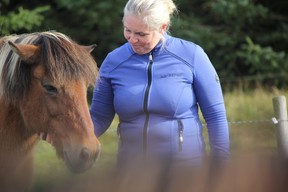
KEEPING PACE
Don’t call them ponies. While the Icelandic horse is considerably smaller than what is found elsewhere in the world, they are incredibly strong, cooperative, versatile and pure. In fact, there is only one breed of horse in Iceland — the Icelandic horse — which arrived with the Viking settlers in the 9th century and has played a big role culturally on the island ever since.
Advertisement 11
Article content
Known for its ability to perform five gaits — the Tölt and Flying pace are Icelandic originals — the horse is used for traditional sheep-herding as well as showing, racing and leisure.
“The horses have just connected so many people,” said Katrín Sigurdardóttir during our tour of family-run Skeiðvellir, or Icelandic Horseworld. “They are friendly, strong horses with unique gaits.”
There are about 80,000 Icelandic horses on the island, compared to about 370,000 people.
PRO TIP: These horses love attention, just make sure to share the love.
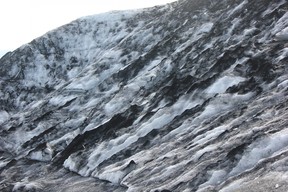
FRANK DISCUSSION
Nothing stirs controversy quite like traditional food.
The great debate apparently never really stops when it comes to Iceland’s unofficial national dish, the Icelandic hotdog — specifically, how to dress it.
Advertisement 12
Article content
Our southern friends suggested the best dog — referred to as pylsur or pulsar — is dressed in the order of bun, ketchup, remoulade, crispy fried onions, raw onions, dog and a sweet brown mustard called Pylsusinnep. Our northern-raised tour guide, Stefan, whose deep voice could probably cause an earthquake, suggested the mustard goes at the bottom, not the top.
“It’s so much easier to eat because everything is less messy,” said Stefan, who is trained in opera and also served as a police officer for a few decades.
The southerners also suggested there was nothing better after a night of drinking than a hotdog and chocolate milk. But Stefan, a northerner, disagreed.
Among the non-hotdog foods we tried were hákarl (fermented shark) — we can report that once was enough, thank you very much, cod, puffin, Brennivin schnapps, and, best of all, lamb. Oh, and chocolate-covered licorice.
Advertisement 13
Article content
PRO TIP: Try the hotdog. And for a truly unique experience, visit Dome Auðkúla for coffee and waffles in a geodesic dome. Craving Nutella fries? Visit Smiðjan Brewery.
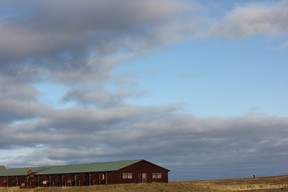
HOME ON THE RANGÁ
With fingers crossed, I dutifully pressed the button on my room phone every day.
“You’ve successfully ordered a wake-up call for the Northern Lights,” a pre-recorded voice confirmed, though the call never came.
All week, Mother Nature opted against revealing her colourful dance in the sky to our group. No matter. Not that I needed another reason to return to Iceland, but a chance to witness the great light show in the sky will be enough to entice me back.
Ditto for Hotel Rangá, a gloriously quirky four-star property located on the banks of the Rangá River and within view of the Mt. Hekla volcano along the island’s south coast, about 90 minutes by car from the international airport in Keflavik.
Advertisement 14
Article content
The first indication you’re not at a chain hotel is the giant stuffed polar bear (Hrammur is his name) that greets you upon entry to the hotel lobby. The at-times off-the-wall decor is in abundance throughout the 51-room hotel, including a “harp chair” that doubles as a trust-building exercise and an art installation that dispenses “leaf receipts” based on the amount of sunlight on any given day.
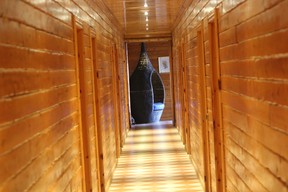
There are unique hand-painted murals in each room. The interior construction features mostly white beech and pine, the overall feel that of Texas ranch-meets-northern cabin.
If the vibe feels familiar for Canadian guests, that’s because it should.
“Practically everything comes from Canada,” said Hotel Rangá owner Fridrik Pálsson, who spent significant time in the Great White North during his nearly 30 years leading two of Iceland’s largest seafood-export companies. “I can say it’s as Canadian as it can be.”
Advertisement 15
Article content
In addition to standard rooms, the hotel offers suites in the theme of the seven continents, with decor imported from each. The suites have played host to such celebrities as the Kardashians and Justin Bieber (who stayed in Room No. 10, a standard room located next to mine, which basically makes me part of his entourage or something).
Other highlights include geothermal-heated hot tubs and the excellent Restaurant Rangá, specializing in Nordic fare including to-die-for wild mushroom soup and perfect cuts of lamb. Look for the outlandish “female legs” seating at the restaurant bar, perfectly contributing to the overall aesthetic.
-
![The facade of the 124 on Queen Hotel & Spa blends seamlessly with the streetscape of Niagara-on-the-Lake's Old Town streetscape.]()
OLD TOWN, NEW TAKE: 124 on Queen brings modern accommodation to Niagara-on-the-Lake
-
![The view from the Sheraton Centre Toronto Hotel's exlusive 43rd-floor lounge.]()
CENTRE OF ATTENTION: Enjoy 360 views of Toronto from new-look Sheraton Club
-
![A weekend getaway to Toronto with the guys can be more than just beers and a sporting event.]()
Guys’ getaway in Toronto celebrates return to ‘normalcy’ with a touch of luxe
Advertisement 16
Article content
Should the Aurora Borealis show up during your stay, you’ll be well-equipped thanks not only to the wake-up call service but also the spectacular on-site observatory, which is open on clear nights. Guests have access to warm snowsuits and blankets, while a local astronomy expert is brought in for star-gazing talks. There are two massive telescopes on site: Reflector and refractor models.
The hotel is located in the countryside of Hvolsvöllur, considered the adventure capital of Iceland, and is central to the famous Golden Circle and about an hour’s drive to the capital city of Reykjavik.
“This turns out to be absolutely in the middle of almost everything you can think of. In that respect, we’ve been very lucky,” Pálsson said.
Advertisement 17
Article content
The hotelier is part of a group that recently purchased the island’s first electric plane, accessible to guests with arrangements made through the hotel.
PRO TIP: The available boot driers should come in handy in rainy Iceland. Just ask the front desk.
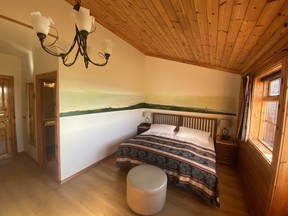
ICELAND FAST FACTS
* Approx. population: 350,000. It was one of the last places on earth to be settled by humans, and 80% remains uninhabited.
* No mosquitoes, nor McDonald’s or Starbucks.
* The belief in elves — aka The Hidden People — and trolls is common.
* Beer was banned until 1989 (they celebrate Beer Day on March 1) and, to this day, it’s illegal to own snakes, lizards or turtles as pets.
* The Icelandic flag’s colours represent: Blue for water, red for fire, and white for ice.
Advertisement 18
Article content
* An Icelandic last name is taken either from the father or mother’s first name, plus -dóttir (for daughter) or -son.
* Iceland is well on its way to energy independence, with more than 70% of its energy coming from its own renewable sources.
— Source: Hotel Rangá
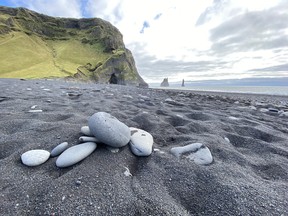
HOW TO GET THERE
We flew via Icelandair, which flies direct from Toronto (YYZ) to Reykjavik (KEF). Additionally, when you fly trans-Atlantic with Icelandair, you can choose to add a one- to seven-day stopover in Iceland at no extra airfare charge. Icelandair’s Saga Premium service includes a series of superb upgrades and exclusive lounge access.
Stay connected with us on social media platform for instant update click here to join our Twitter, & Facebook
We are now on Telegram. Click here to join our channel (@TechiUpdate) and stay updated with the latest Technology headlines.
For all the latest Travel News Click Here




